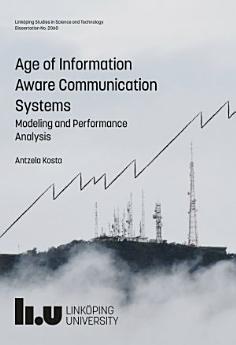Age of Information Aware Communication Systems: Modeling and Performance Analysis
About this ebook
The first part of the thesis considers multiple access communication systems and comprises two papers. The first paper, investigates AoI in relation with throughput in a shared access setup with heterogeneous traffic. More specifically, we consider a shared access system consisting of a primary link and a network of secondary nodes, with multipacket reception (MPR) capabilities. To study the joint throughput-timeliness performance, we formulate two optimization problems considering both objectives and provide guidelines for the design of such a multiple access system satisfying both timeliness and throughput requirements.
In the second paper, we study the AoI performance in various multiple access schemes, including scheduling and random access. We present an analysis of the AoI with and without packet management at the transmission queue of the source nodes, considering that packet management is the capability to replace unserved packets in the queue whenever newer ones arrive. We incorporate the effect of channel fading and network path diversity in such a system and provide simulation results that illustrate the impact of network operating parameters on the performance of the considered access protocols.
The second part of the thesis considers the characterization of AoI and other freshness performance metrics in a point-to-point communication link, again comprising two papers. In the third paper of this thesis, we expand the concept of information ageing by introducing the cost of update delay (CoUD) metric to characterize the cost of having stale information at the destination. Furthermore, we introduce the value of information of update (VoIU) metric that captures the degree of importance of the update received at the destination. We employ queue-theoretic concepts and provide a theoretical analysis and insights into the prospects of cost and value.
Finally, in the last paper, we study the properties of a sample path of the AoI process, and we obtain a general formula of its stationary distribution. We relate this result to a discrete time queueing system and provide a general expression of the generating function of AoI in relation with the system time, and the peak age of information (PAoI). To illustrate the applicability of the results, we analyze the AoI in single-server queues with different disciplines and assumptions. We build upon these results to provide a methodology for analyzing general non-linear age functions for this type of systems.








